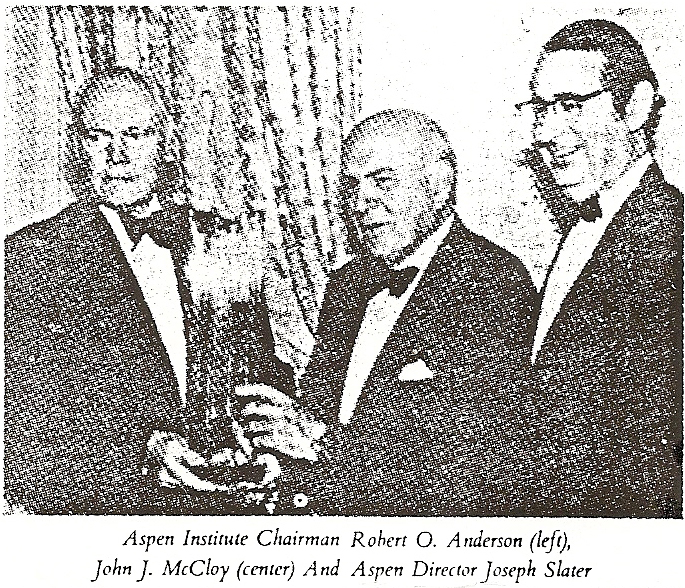Alaska
Wilderness Lands were locked up. (Anderson could rest assured that “free enterprise” was good enough for
him but for very few others). The Aspen Institute for Humanistic Studies was
founded by Robert Hutchins in 1949, and since 1963, has been run by Robert O.
Anderson.
In 1949, Hutchins had launched the
Committee to Frame a World Constitution at the University of Chicago. The
Committee and its journal, Common Cause, worked in close collaboration with the
British Crusade for World Government and served as a rallying point for both
“one world” currents in the U.S. – the U.C. based “World Republicans” and the
“World Federalists” led by Norman Cousins, Cord Meyer and Carl Van
Dorren.
Hutchins then went on to the
Presidency of the newly reorganized Ford Foundation, which was the largest
foundation in the world, and is today the biggest founder of environmentalism.
Through the 1950’s and the 1960’s, Hutchins created four institutes and
foundations. Emerging from these
organizations came the Institute of Policy Studies which, beginning in 1963, has
educated, developed and controlled virtually the entire “New Left”
movement.
The Aspen Institute is based in
New York City and Aspen, Colorado, with satellites in West Berlin, Tokyo,
Hawaii, Jerusalem, Washington D.C., Stanford Research Institute in Palo Alto,
and the Princeton Center for Advanced Studies. It was established as a small,
tightly organized international network of social
engineers.
Amidst the multitude of reports,
conferences and Executive Seminar programs for corporate Executives sponsored by
Aspen a persistent theme emerges: “we live in an era of limited resources,” “we
must limit growth,” “the nation-state is outmoded”.
Besides Hutchins and Robert O.
Anderson, the key Aspen figure is Joseph Slater, Slater was brought on board
from the Ford Foundation to assume the presidency of Aspen 1969 when Anderson
took the chairmanship. Slater had worked at various allied political command
posts under Dillon Reed banker General William Draper during WWII, including a
tear in the State Department’s United Nations Affairs division, and returned to
Germany in 1949 to work under John K. McCloy in the Occupation Directorate.
McCloy soon promoted Slater to Secretary General of the Allied High Commission.
In 1957 when John J. McCloy took over the Ford Foundation, he brought Slater in.
In 1961 Slater was made Director of International Affairs at the Ford Foundation
and asked to draft a Ten Year Plan for disbursal of some $3 billion in
grants.
Slater’s plan included the Ford
Foundation’s 1969 Project on the Environment that officially kicked off the
attack on industry and technology in the U.S. we today call the environmental
“movement”.
One of the first things to occur
after Slater took over the presidency of Aspen (and simultaneously directorship
of Robert O. Anderson’s own tax shelter, the Anderson Foundation), was that
Robert O. Anderson personally financed a propaganda campaign on university
campuses that culminated in the spring 1969 “Earth Day,” the first nationwide
rally to protest the “destruction of the environment” by modern civilization. It
was the first step in a deliberate effort to create a climate of sympathy for
Malthusian zero growth where none yet existed in the U.S.
Also, in 1969, Robert O. Anderson
personally contributed $200,000 in seed money to launch Friends of the Earth
(FOE) the first of the new environmentalist groups to be set up by the
zero-growth elite. Most of the early membership of the FOE was drawn from the
World Federalist and the Planetary Citizens, both postwar organizations linked
closely to Anderson mentor Robert Hutchins and his two closest British
collaborators, Bertrand Lord Russell and Aldous Huxley. Such World Federalist
founders as Norman Cousins, also a member of the FOE Council, were members of
the Aspen Institute at the time. These “environmentalist” groups drew heavily
from the rabble of anti-war activists engaged in anti-Viet Nam actions who were
being “educated” by the Institute for Policy Studies.

At the same time, Slater
commissioned a six-month project, a global overview of the state of the
conservation and environmentalist movement to monitor the responsiveness within
the U.S. Congress and foreign governments to environmentalist legislation. The
report, “International Environmental Action – A Global Survey,” was prepared by
Aspen associate Thomas Wilson of MIT, published by Aspen, and widely circulated
under the title. The Environment: Too
Small a View. The report argued that a global social policy approach to the
environment was needed; one that would take into account the necessity of
forcing governments and corporate entities to submit to centralized limits to
growth and international regulation of energy and other vital raw materials.
On the basis of this report, released as the U.S. Congress was passing the
National Environmental Protection Act (NEPA) in 1969, Aspen initiated a series
of seminars in 1970 to spread the zero-growth message, targeting especially
those intellectuals and journalists in a position to influence public opinion.
Among the participants, for instance, was James Reston of the New York Times.
Slater and the Aspen Institute then enlisted the help of United Nations Organization. The U.N. Conference on the Environment, scheduled for Stockholm in June 1972 was then director of the state owned Petro Canada, head of the International Development